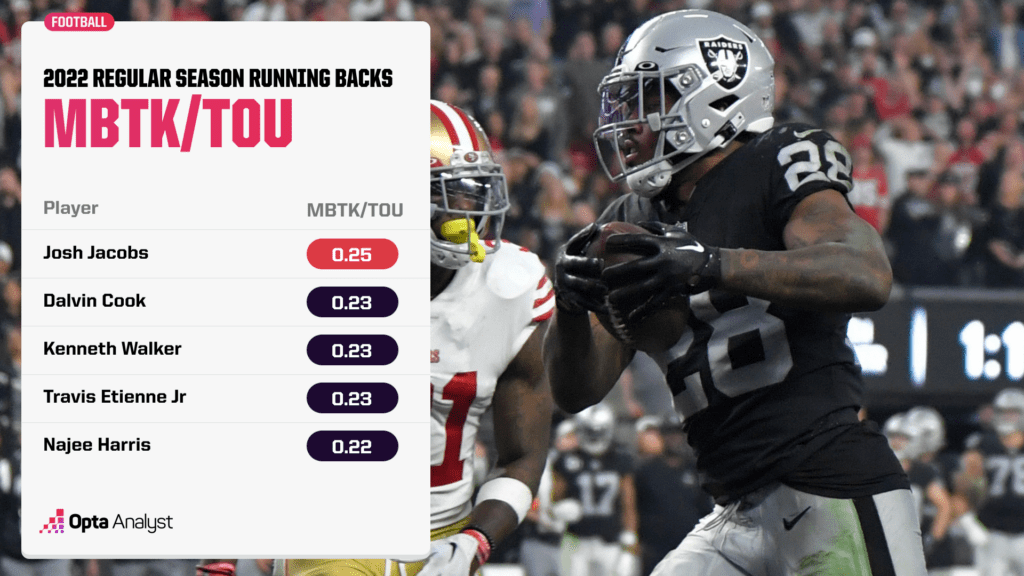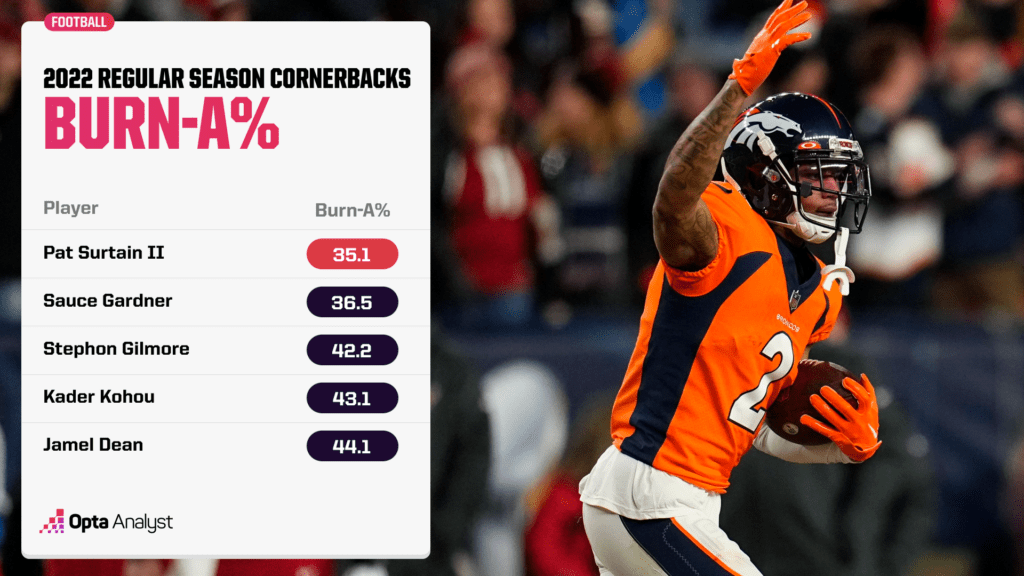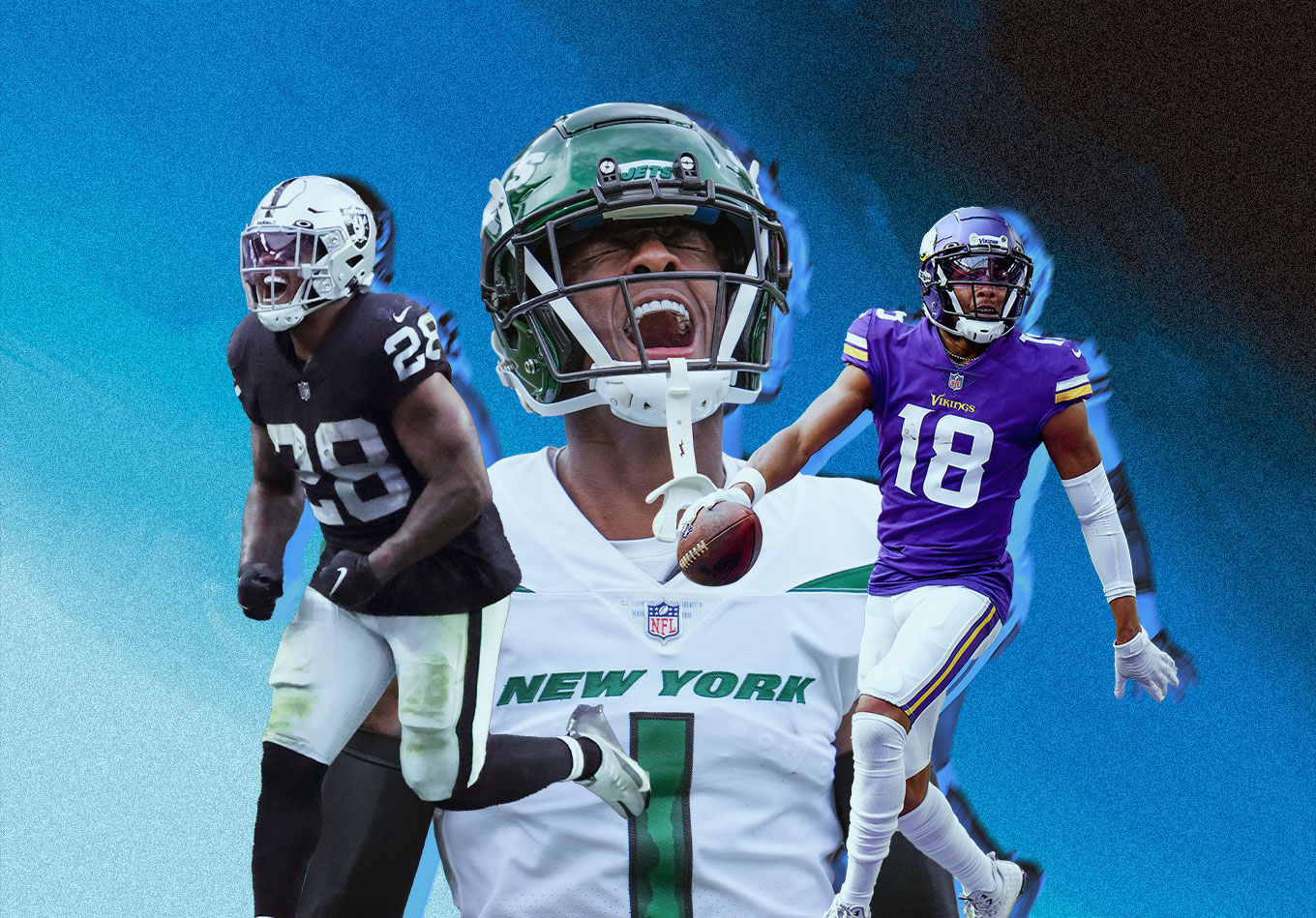The Associated Press 2022 NFL All-Pro Team was announced last month, highlighted by Sauce Gardner’s inclusion as the first rookie cornerback selected in 41 years.
That prestigious team is voted on by 50 members of a nationwide panel of media members who regularly cover the league. In other words, it’s highly subjective based on performance but also potentially influenced by popularity and other biases.
But this list isn’t. The data has no biases. Let’s get to the players our data indicates were the best at their positions in 2022.
Offense
Quarterback
- First Team: Patrick Mahomes, Kansas City Chiefs
- Second Team: Jalen Hurts, Philadelphia Eagles
The best two quarterbacks in football all season, these are the two leading candidates for MVP. Oh yeah, and their two teams are playing in the Super Bowl next weekend. No need to overthink this one. Led by Mahomes, the Chiefs were No. 1 in the league in passing offensive EVE (Efficiency Versus Expected).
Running Back
- First Team: Josh Jacobs, Las Vegas Raiders
- Second Team: Christian McCaffrey, San Francisco 49ers
From having his fifth-year option declined by the Raiders to ultimately producing the season he did, Jacobs was incredible this season. He led the NFL in rushing yards and runs of 10 or more yards. Among the 12 running backs with more than 220 carries, Jacobs was first in forcing missed or broken tackles per touch and second only to Nick Chubb in yards after contact.

McCaffrey just barely gets the nod over Derrick Henry because he transformed the 49ers offense once he came over in the midseason trade. He finished with over 1,100 rushing yards and led the running back position in receiving yards with 741.
Wide Receiver
- First Team: Justin Jefferson, Minnesota Vikings
- Tyreek Hill, Miami Dolphins
- Davante Adams, Las Vegas Raiders
- Second Team: Stefon Diggs, Buffalo Bills
- A.J. Brown, Philadelphia Eagles
- Ja’Marr Chase, Cincinnati Bengals
One of the most brutal calls of the whole exercise was the last remaining player to slot into the first team. Adams was doubled more than any other receiver in football, but he still finished second in burn yards per route among receivers with at least 70 targets. He also led the NFL in touchdown receptions. Of course, Hill finished first in burn yards per route and was one of the key reasons why Tua Tagovailoa was so successful. Jefferson was a no-brainer.
That pushed Diggs to the second team despite a season in which he finished second in burn percentage among all players with 100 targets and in the top five in receptions, receiving yards and receiving touchdowns.
Tight End
- First Team: Travis Kelce, Kansas City Chiefs
- Second Team: George Kittle, San Francisco 49ers
For the second straight season, Kelce and Kittle were the two best players at their position. As the co-founders of the tight end university, it’s only fitting that these two find themselves on this list. Kelce was incredible and is putting together a case for the greatest receiving tight end ever. Kelce ranked first and Kittle third in burn percentage among NFL tight ends with at least 70 targets. Kittle makes it on here not only because he’s exceptional in the receiving game, but because of his sensational work in the run game.
Blocking Tight End
- First Team: Geoff Swaim, Tennessee Titans
- Second Team: Marcedes Lewis, Green Bay Packers
Swaim was second among all tight ends with 117 (Brock Wright of the Detroit Lions was first) 1-on-1 run-blocking matchups and won 72.7% of his matchups finishing behind only Kittle – a testament to Kittle’s prowess in the run game. Lewis was fourth in 1-on-1 matchups and third in win percentage.
Left Tackle
- First Team: Laremy Tunsil, Houston Texans
- Second Team: Trent Williams, San Francisco 49ers
It’s not Tunsil’s fault the Texans struggled so much. Maybe the most astounding stat of this entire exercise was that Tunsil only lost four 1-on-1 matchups all season and his stunt-adjusted pass protection win rate of 95.7% was astronomically better than any other lineman in football – no one else finished above 90%. Williams’ combination of pass protection and devastating run domination earned him the second-team selection over Andrew Thomas of the New York Giants.
Left Guard
- First Team: Joel Bitonio, Cleveland Browns
- Second Team: Quenton Nelson, Indianapolis Colts
While pass protection is the critical element of the position for left tackles, the run game comes more into effect for the interior offensive line. To that end, we have a statistic that measures run-blocking opportunities per snap. Among all left guards, Nelson finished first with 0.84 opportunities per snap. And when that number is combined with win rate, it essentially measures how often you are used in the run game and how good you are. Bitonio and Nelson finished first and second, respectively.
Center
- First Team: Jason Kelce, Philadelphia Eagles
- Second Team: Frank Ragnow, Detroit Lions
Maybe the two easiest calls were the Kelce brothers, as Jason was the best center in football by a huge margin. He finished first among all centers in run-block win rate (83.8%) and second in stunt-adjusted pass protection win rate (82.3%). His only competition came from Ragnow, who was one of the key reasons why Jamaal Williams ended the season with 17 rushing touchdowns. He finished second in run blocking win rate (80.0%) and fourth in pass block win rate (76.2%).
Right Guard
- First Team: Zack Martin, Dallas Cowboys
- Second Team: Chris Lindstrom, Atlanta Falcons
Lindstrom had a revelatory season for the Falcons, finishing second among right guards with 0.84 run-blocking opportunities per snap and second in the metric which combines opportunities and win rate. So, he slots in behind Martin, who is the game’s best right guard and has now made an All-Pro team in eight of his nine seasons in the NFL.
Right Tackle
- First Team: Lane Johnson, Philadelphia Eagles
- Second Team: Penei Sewell, Detroit Lions
Right tackle was a loaded position this season and yet, Johnson still ended the year as a no-doubter on the first team. In the aforementioned stunt-adjusted win rate metric, Johnson finished second among all offensive linemen at 89.7% for the NFC champs. Tristian Wirfs of the Tampa Bay Buccaneers finished third (89.7%) but gets edged out for the second-team spot by Sewell. The second-year pro out of Oregon was elite in pass protection, but even more dominant in the run game. He was fifth among all right tackles with 0.62 run-blocking opportunities per snap but finished first when combined with win rate.
Defense
Defensive Tackle
- First Team: Chris Jones, Kansas City Chiefs
- Quinnen Williams, New York Jets
- Second Team: Dexter Lawrence, New York Giants
- Aaron Donald, Los Angeles Rams
Donald is still the king of the position, and he might just be the best player in football, period. He led all defensive tackles in pressure rate (25.8%) and run disruption rate (an absolutely absurd 42.5%). Just take a look at this graphic which displays where all interior defensive linemen finished in those two categories during the regular season.
But he only played 11 games, so he gets knocked from the first to second team. Jones (our defensive player of the year), Williams and Lawrence combined with Donald to form the top four at the position in pressure rate.
Edge
- First Team: Nick Bosa, San Francisco 49ers
- Myles Garrett, Cleveland Browns
- Second Team: Micah Parsons, Dallas Cowboys
- Maxx Crosby, Las Vegas Raiders
Bosa was easily one of the NFL’s best edge rushers, leading the league in sacks (18.5) ahead of Haason Reddick (16) and Garrett (16). Choosing between Garrett and Parsons is essentially impossible, but Garrett was double-teamed more (39.9% versus 23.6%). That’s partly because when he was left 1-on-1, Garrett won his matchup 64.42% of the time – by far the best rate among any edge players. Crosby gets the final spot for playing all the time – over 1,000 snaps (by comparison, Bosa played 863) – and for his work in the run game where he had 19 more run disruptions than the next closest player.
Linebacker
- First Team: Fred Warner, San Francisco 49ers
- Matt Milano, Buffalo Bills
- Second Team: Roquan Smith, Baltimore Ravens
- Demario Davis, New Orleans Saints
Among the top 22 linebackers in overall pass coverage snaps, Warner finished second in both snaps (548) and fewest burns allowed (19). He and Milano were the two best linebackers all season. Smith transformed the Ravens defense into an elite unit after he was acquired and was particularly strong in the run game where he finished sixth in run disruptions among linebackers. Davis was the only player to allow fewer burns than Warner and so he gets the nod over Bobby Wagner for the final spot.
Cornerback
- First Team: Sauce Gardner, New York Jets
- Patrick Surtain II, Denver Broncos
- Second Team: Darius Slay, Philadelphia Eagles
- Tyson Campbell, Jacksonville Jaguars
Among the cornerbacks with more than 200 pass coverage snaps, Sauce finished first in open-allowed percentage (50.0%). Meanwhile, among the 36 cornerbacks with at least 400 pass coverage snaps, Surtain and Gardner finished first and second, respectively, in burn-allowed percentage.

Nobody, however, played more pass coverage snaps than Campbell, who came from out of nowhere to produce an elite season. He finished second among those 36 cornerbacks in burn yards allowed per target (7.6). Jaire Alexander, who made AP’s All-Pro second team, misses the cut here.
Nickel Cornerback
- First Team: K’Waun Williams, Denver Broncos
- Second Team: Kyle Hamilton, Baltimore Ravens
Williams was the only nickel cornerback in the top 15 in pass coverage snaps to not allow a single touchdown burn all season. Hamilton, along with the Ravens defense, took off after the Smith trade. His 12.4 big play percentage was the best among all nickel cornerbacks with at least 175 pass coverage snaps.
Strong Safety
- First Team: Derwin James, Los Angeles Chargers
- Second Team: Budda Baker, Arizona Cardinals
James was the best coverage safety all season, allowing only 5.9 burn yards per target (Sauce was the top cornerback at 7.2). He also finished fifth at the position in tackles. The second spot behind James was a question mark and we ultimately settled on Baker, who was solid in both pass and run scenarios on a team in which he didn’t have a lot of help.
Free Safety
- First Team: Minkah Fitzpatrick, Pittsburgh Steelers
- Second Team: Jevon Holland, Miami Dolphins
Fitzpatrick, who played in Sunday’s Pro Bowl events, led the league in interceptions and is the preeminent ballhawk in today’s NFL. Holland gets the second spot here to highlight how well he played in such difficult circumstances. The Dolphins rushed at least five players on 35.3% of drop backs – the second-highest mark in the league. That often left Holland to cover a ton of ground as the free safety – a task he performed extremely well.
Swiss Army Knife
- Kyle Dugger, New England Patriots
Dugger was in the discussion for three different positions on this list, but he settles in as the game’s most versatile player this season. He finished with four takeaways and two touchdowns. He lined up at inside linebacker for 156 snaps, deep safety for 151 snaps, inside cornerback for 140 snaps, outside linebacker for 100 snaps, box safety for 96 snaps, and outside cornerback for 49 snaps. And by the way, he also had one kickoff return on special teams for 37 yards.
